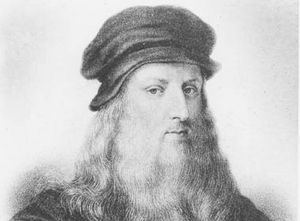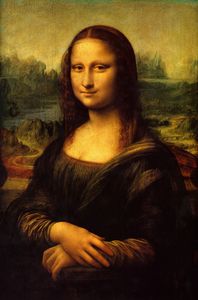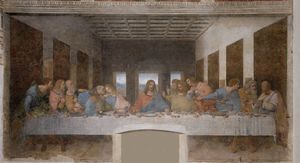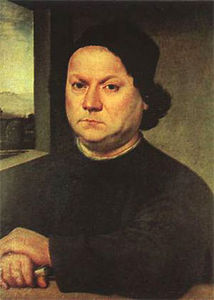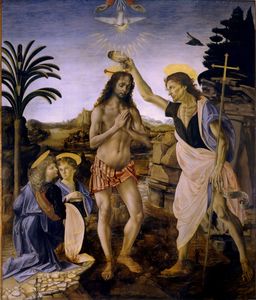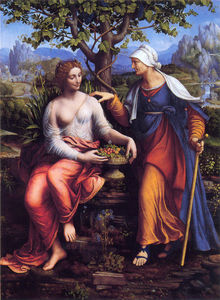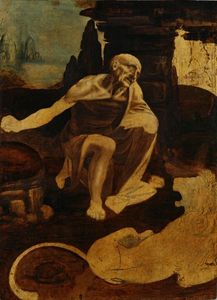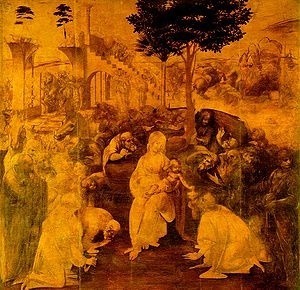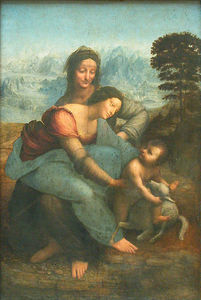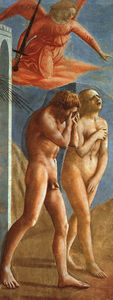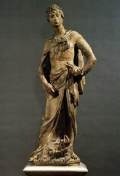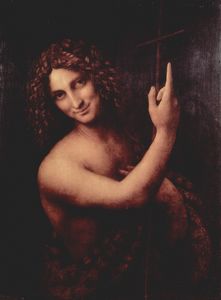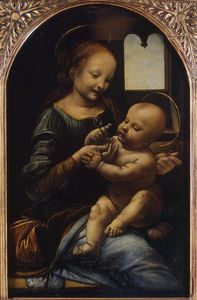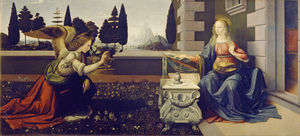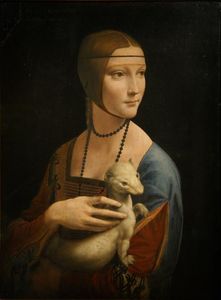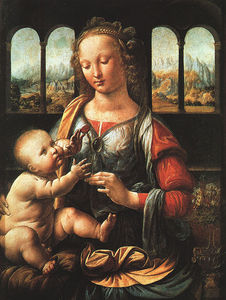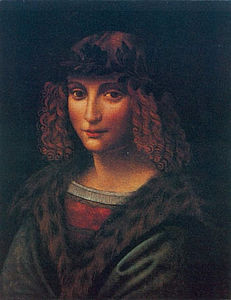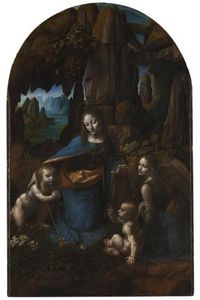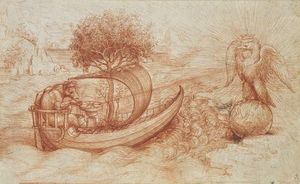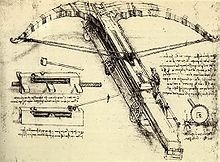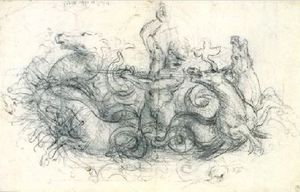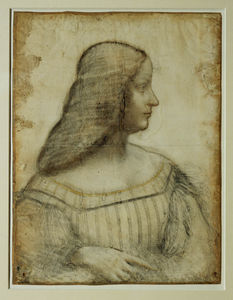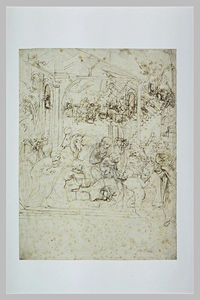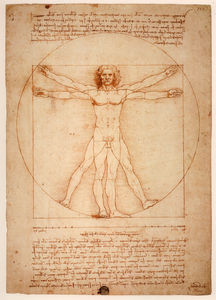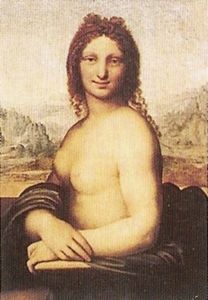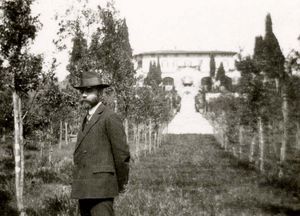Leonardo da Vinci
- Full Name:
- Leonardo di ser Piero da Vinci
- Date of Birth:
- 16 Apr 1452
- Date of Death:
- 02 May 1519
- Focus:
- Paintings, Drawings
- Mediums:
- Oil, Tempera, Wood, Other
- Subjects:
- Figure, Landscapes
- Art Movement:
- Renaissance
- Hometown:
- Florence, Italy
- Leonardo da Vinci Page's Content
- Introduction
- Biography
- Style and Technique
- Who or What Influenced
- Works
- Followers
- Critical Reception
- Bibliography
Introduction
Born Leonardo di ser Piero da Vinci but more commonly known as Leonardo da Vinci, the Italian artist was a supremely talented individual. As well as a skilled painter he was also, among other things, a sculptor, architect, musician, scientist, inventor and writer.
Leonardo is often referred to as an artist who epitomized Renaissance art and one with a "feverishly inventive imagination". He is among the greatest painters in history and, some claim, the most gifted person the world has ever known.
Da Vinci's unique powers of observation and competence as an illustrator allowed him to recreate the effects he saw in nature, and added vigor to his portraits. A curious individual, he tried to explain what he saw and carried out detailed research and undertook experiments to test his ideas.
His sketches and recordings in countless notebooks made him one of the first men to adopt a scientific approach towards understanding the world and how we see it. Many argue that Leonardo had one of the best scientific minds of his time.
In the words of his biographer, Giorgio Vasari;
"The most heavenly gifts seem to be showered on certain human beings. Sometimes supernaturally, marvelously, they all congregate in one individual. . . . This was seen and acknowledged by all men in the case of Leonardo da Vinci, who had. . . an indescribable grace in every effortless act and deed. His talent was so rare that he mastered any subject to which he turned his attention. . . . He might have been a scientist if he had not been so versatile".
Despite his achievements as a scientist and inventor, it is for his artistic contribution that Leonardo is most fondly remembered and some of his artworks are considered the greatest masterpieces ever created.
Leonardo da Vinci Biography
Early years:
Leonardo da Vinci was born on April 15 1452, in Vinci, in the region of Florence, Italy. The illegitimate son of Messer Piero Fruosino di Antonio da Vinci, a wealthy Florentine legal representative, and Caterina, a peasant woman, Leonardo had no surname - 'da Vinci' simply means 'of Vinci'.
Little information exists concerning Leonardo's early life but it's known that his parents separated and he spent time living with both. His mother remarried and both parents had children with their respective partners, meaning Leonardo had a total of 17 half brothers and sisters.
Growing up in his father's Vinci home, Leonardo was immersed in the town's painting tradition, and at the age of 15 he took up an apprenticeship with Andrea del Verrocchio whose workshop was highly esteemed in Florence in particular. Other renowned painters who attended it include Botticelli, Perugino, Domenico Ghirlandaio and Lorenzo di Credi.
Vasari claims that Leonardo shined as an apprentice and often assisted his master with his commissions, most notably Baptism of Christ. Da Vinci was given the task of painting the young angel holding Jesus' robe and Vasari states that his work excelled that of his teacher, so much so that Verrocchio vowed never to paint again.
By the age of twenty Leonardo qualified as a master in the Guild of St Luke, the union of artists and doctors. His father established a workshop for him but he continued painting with Verrocchio, the two clearly sharing a close bond. Leonardo's first recognized work is a pen and ink drawing of the Arno valley, which he finished on August 5, 1473.
Leonardo spent the next ten years working in Florence. Few of his paintings from this period survive but he created several drawings that demonstrated his keen interest in other disciplines, such as anatomy, geometry and engineering.
After ten years he relocated to Milan, believing it harbored more exciting opportunities. There he was commissioned by a confraternity to create an altarpiece, the result being The Virgin of the Rocks.
Middle years:
Leonardo's major achievement from this time was The Last Supper, which perfectly illustrates his belief that poses, gestures and facial expressions should mirror the motions of the soul and mind. Similarly, his portrait Mona Lisa was immensely popular thanks to the sitter's mysterious expression.
The artist's stay in Milan lasted until 1513 and after that he spent three years in Rome. At some point during this period he was offered employment as 'first painter and engineer' at the royal court which he accepted. He moved to the Chateau of Cloux, near Amboise in 1517 and remained there for the rest of his life.
Later years:
Ill health plagued Leonardo and a stroke left him paralyzed down the right side of his body. Nevertheless, he kept busy and relied on his assistants to carry out most of the physical work. However, his mood worsened and it's thought that he was overwhelmed by cynicism.
Da Vinci dedicated more time to his experiments and scientific assignments which hindered his artistic commissions and he finished less and less of his work. He completed so few paintings during his career that it was hard to decipher his original works from imitations and copies.
In April 1519 a 67-year-old Leonardo devised a will and left the majority of his collection to his acclaimed pupil and companion, Francesco Melzi. He died later that year and was buried in Amboise. Vasari records that King Francis, a trusted friend of the artist, held his head in his arms as he died but others contest this.
Leonardo da Vinci Style and Technique
Da Vinci made a scientific study of light and shadow in nature and realized that objects were not composed of outlines, but were actually three-dimensional and characterized by light and shadow. A technique known as chiaroscuro, this realization and experimentation gave his paintings the soft, lifelike quality that made older works appear flat.
Leonardo also understood that an object's color and detail changed as it retreated in the distance. Such a technique, called sfumato, was first developed by Flemish and Venetian painters, but with da Vinci's artistic genius, it became a powerful tool that created atmosphere and depth.
Early works:
In the 1480s Leonardo was given two vital commissions and began another that was highly significant because of its composition. One of these paintings was St. Jerome in the Wilderness. Despite the fact the painting is barely started, the composition is very unusual. The landscape elements, drama and arrangement of figures featured in this work are emulated in another of Leonardo's great unfinished masterpieces, the Adoration of the Magi.
Paintings of the 1490s:
The most famous work to emerge from this period was The Last Supper. Despite Leonardo's concerns over portraying the faces of the figures, the painting was hailed a masterpiece. Sadly, The Last Supper deteriorated rapidly due to the fact that Leonardo had used materials that were prone to mold and flaking. Nonetheless this image remains one of the most reproduced works of art.
Paintings of the 1500s:
Da Vinci employed the technique of sfumato (later referred to as Leonardo's smoke) to produce his most renowned artwork, Mona Lisa. Other qualities of this painting are the simple dress, the dramatic scenery, subdued color palette and the extremely smooth nature of the work, where oils have been blended on the surface to hide any trace of the brush stroke.
In the Virgin and Child with St. Anne, which also employs the subtle sfumato technique, the composition is similar to the Mona Lisa in that the figures are set in extremely beautiful surroundings. However, Virgin and Child with St. Anne is rare because there are two figures set on an angle and superimposed.
This work was copied many times and it influenced Michelangelo, Raphael, Andrea del Sarto, Pontormo and Correggio. Moreover, these trends in composition were adopted by the Venetian painters Tintoretto and Veronese.
Drawings:
Leonardo created a series of compositions of the Virgin and Child and before painting, he would work out his arrangement in a sketch. He was a creative draftsman and had numerous notepads crammed full of small drawings.
He carried out several studies referred to as "caricatures" because, although embellished, they appear to be drawn from live models. Vasari stated that Leonardo would often follow people he deemed interesting and would make sketches of them all day long.
Who or What Influenced Leonardo da Vinci
Verrocchio:
Leonardo began his career under the tuition of Verrocchio in around 1466, the same year that Verrocchio's master, Donatello, passed away. Verrocchio's specialty was perspective, which at this time artists were just beginning to grasp. Leonardo soon overcame its challenges and by his early twenties was already a distinguished artist.
Florence:
When Leonardo was growing up Florence was the hub of Christian Humanist theory and culture and with Alberti, he attended the Medici home and was introduced to the older Humanist philosophers, such as Marsiglio Ficino and John Argyropoulos.
Renowned artists of the time included Piero della Francesca, Fra Filippo Lippi, sculptor Luca della Robbia and architect and writer Leon Battista Alberti. Donatello's contemporaries included Masaccio and Ghiberti. All of these artists inspired emerging painters but della Francesca's systematic study of light and Alberti's thesis greatly impacted Leonardo's own studies and artworks.
Masaccio's image of Adam and Eve leaving the Garden of Eden depicted hugely expressive figures and its use of light and shade meant that it became three-dimensional. This technique was later expanded on by Leonardo and was influential in the course of painting. Furthermore, Donatello's David had a Humanist influence on Leonardo's later works, especially St John the Baptist.
Small altarpieces were very traditional in Florence, particularly those depicting the Virgin and Child and Leonardo's early offerings such as The Benois Madonna were in keeping with this tradition but were still unique. The compositional ideas established in this work were developed in later paintings by the artist, including The Virgin and Child with St. Anne.
Other artists:
In 1476, Hugo van der Goes' Portinari Altarpiece introduced new techniques to Florence that would greatly impact on Leonardo's art and that of his contemporaries such as Ghirlandaio and Perugino.
Three years later in 1479, Sicilian painter Antonello da Messina, who worked solely with oils, traveled north en route to Venice and upon seeing his work Giovanni Bellini took up oil painting and it soon became the preferred medium in the city. Leonardo later visited Venice and was influenced by such advances.
Science:
In the quest to improve his artwork, Leonardo turned to science. His study of nature and anatomy was evident in his superbly realistic paintings, and his understanding of the human body paved the way for remarkably precise figures. He was the first painter to study the physical proportions of the human body and to use these analyses to determine the "ideal" form.
Unlike many of his contemporaries -- for example, Michelangelo - Leonardo did not indulge in painting overly muscular figures.
Leonardo da Vinci Works
Leonardo da Vinci Followers
Gian Giacomo Caprotti da Oreno:
Nicknamed Salai or Il Salaino ('The Little Unclean One' i. e., the devil), da Oreno entered Leonardo's home in 1490 and despite a tumultuous start, he worked under the artist for the next thirty years.
Salai produced a number of works under the name of Andrea Salai, but most consider his paintings to be less notable than those of Leonardo's other students, such as Marco d'Oggione and Boltraffio.
In 1515, Salai painted a nude version of the Mona Lisa, named Monna Vanna.
Francesco Melzi:
The son of a Lombard aristocrat, Count Francesco Melzi was inducted into Leonardo's household in 1506 and is thought to have been his favorite pupil. He travelled to France with Leonardo, and stayed with him until his master's death after which Melzi was left his artistic and scientific works, manuscripts and collections, and dutifully managed the estate.
Leonardo da Vinci's private life has been the subject of much speculation, particularly his sexuality. The artist's most intimate relationships were perhaps with his pupils Salai and Melzi and since the 16th century it has been claimed that these relationships were of a sexual or erotic nature. Moreover, court records of 1476 show that a 24-year-old Leonardo and three other young men were charged with sodomy, and acquitted.
Consequently, a great deal has been written about the artist's presumed homosexuality and its role in his art, namely the erotic nature of works such as John the Baptist and several drawings.
Leonardo da Vinci Critical Reception
Vasari on Leonardo:
"In the normal course of events many men and women are born with remarkable talents; but occasionally, in a way that transcends nature, a single person is marvellously endowed by Heaven with beauty, grace and talent in such abundance that he leaves other men far behind, all his actions seem inspired and indeed everything he does clearly comes from God rather than from human skill. Everyone acknowledged that this was true of Leonardo da Vinci, an artist of outstanding physical beauty, who displayed infinite grace in everything that he did and who cultivated his genius so brilliantly that all problems he studied he solved with ease".
-

-

Bernard Berenson
Leonardo da Vinci is famed for his paintings first and foremost. Works such as the Mona Lisa, The Last Supper and the Vitruvian Man are among the most esteemed and replicated works in the history of art, rivaled only by the masterpieces of Michelangelo. If it was not for Leonardo's knack of abandoning his commissions then he may have extended his oeuvre but this, together with his experimentation with new techniques, means that only around fifteen of his paintings survive.
Art historian Helen Gardner argues that the scope and depth of Leonardo's interests were without precedent and "his mind and personality seem to us superhuman, the man himself mysterious and remote".
As well as his ground-breaking artworks, Leonardo is admired for his technological abilities. Despite the fact that few of his designs were constructed or feasible during his lifetime, he made important discoveries in the fields of civil engineering and hydrodynamics among others, but the fact that he did not publish these means they had little to no influence on science.
Nevertheless by the 19th century, the extent of Leonardo's notebooks, filled with sketches and ideas, was known and in 1866 Hippolyte Taine wrote: "There may not be in the world an example of another genius so universal, so incapable of fulfillment, so full of yearning for the infinite, so naturally refined, so far ahead of his own century and the following centuries."
In 1896 art historian Bernard Berenson commented: "Leonardo is the one artist of whom it may be said with perfect literalness: Nothing that he touched but turned into a thing of eternal beauty. Whether it be the cross section of a skull, the structure of a weed, or a study of muscles, he, with his feeling for line and for light and shade, forever transmuted it into life-communicating values. "
To this day the interest in Leonardo da Vinci's genius persists. Liana Bortolon, writing in 1967, said: "Because of the multiplicity of interests that spurred him to pursue every field of knowledge ... Leonardo can be considered, quite rightly, to have been the universal genius par excellence, and with all the disquieting overtones inherent in that term. Man is as uncomfortable today, faced with a genius, as he was in the 16th century. Five centuries have passed, yet we still view Leonardo with awe."
Leonardo da Vinci Bibliography
To explore further about the life and works of Leonardo da Vinci please select from the following recommended sources.
• Brown, David Alan. Leonardo da Vinci: Origins of a Genius. Yale University Press, 1998
• Da Vinci, Leonardo. Drawings. Dover Publications Inc. , 1980
• Jones, Jonathan. The Lost Battles: Leonardo, Michelangelo and the Artistic Duel That Defined the Renaissance. Simon & Schuster Ltd. , 2010
• Kemp, Martin. Leonardo da Vinci: The Marvellous Works of Nature and Man. OUP Oxford, 2007
• Marani, Pietro C. Leonardo Da Vinci: The Complete Paintings. Harry N. Abrams, Inc. , 2003
• Syson, Luke. Leonardo Da Vinci: Painter at the Court of Milan. National Gallery Company Ltd. , 2011
• Vezzosi, Alessandro. Leonardo da Vinci: Renaissance Man. Thames & Hudson, 1997
• Zollner, Frank & Nathan, Johannes. Leonardo Da Vinci: The Complete Paintings and Drawings. Taschen GmbH, 2007

